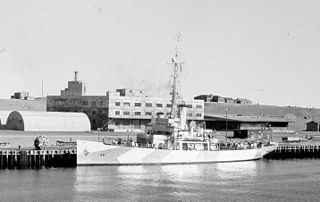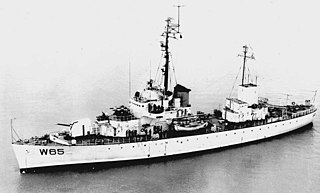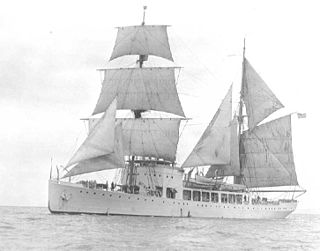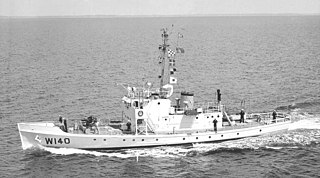
Joseph Francis Farley served as the ninth Commandant of the United States Coast Guard from 1946 to 1949. He was also the first Coast Guard officer to be issued a service number and held #1000 on the Coast Guard officer rolls.

USS Pocatello (PG-117/PF-9), a Tacoma-class patrol frigate, was the only ship of the United States Navy to be named for Pocatello, Idaho.

USCGC Onondaga (WPG-79), a United States Coast Guard cutter, was built by Defoe Boat Works in Bay City, Michigan, commissioned on 11 September 1934. From its commissioning until 1941, Onondaga was stationed at Astoria, Oregon, where she performed important law enforcement duties and rendered much assistance to ships in distress. Each year she patrolled the annual pelagic seal migration to the Pribilof Islands, and she attempted to prevent out of season halibut fishing.

USCGC Modoc (WPG-46) was a 240-foot Tampa-class United States Coast Guard cutter designed for multi-mission roles. She had a top speed of sixteen knots, and was armed with a pair of 5-inch deck guns. With the breakout of war she was armed with depth charges, additional guns, sonar, and radar and transferred to the Navy. Modoc, along with her sister ships Mojave and Tampa joined the Greenland Patrol.

The USCGC Escanaba (WPG-77) was a 165 ft (50 m) "A" type United States Coast Guard cutter stationed on the Great Lakes from her commissioning in 1932 until the start of U.S. military involvement in World War II in 1941. With the outbreak of war, Escanaba redeployed to participate in the Battle of the Atlantic, during the course of which she was ultimately lost with nearly all hands. Struck by either a torpedo or mine in the early morning of 13 June 1943, while serving as a convoy escort, Escanaba suffered a fiery explosion and sank within minutes, leaving only two survivors and one body out of her 105-man crew to be found on the surface by rescuers.

USS Biscayne (AVP-11), later AGC-18, was a United States Navy Barnegat-class seaplane tender in commission as a seaplane tender from 1941 to 1943 and as an amphibious force flagship from 1943 to 1946. She saw service during World War II. Transferred to the United States Coast Guard after the war, she was in commission as the Coast Guard cutter USCGC Dexter (WAGC-385), later WAVP-385 and WHEC-385, from 1946 to 1952 and from 1958 to 1968.

The third USS Casco (AVP-12) was a United States Navy Barnegat-class small seaplane tender in commission from 1941 to 1947. She saw service in World War II. After her decommissioning, the U.S. Navy loaned her to the United States Coast Guard, in which she served as the cutter USCGC Casco (WAVP-370), later WHEC-370, from 1949 to 1969.

USCG Winnebago (WHEC-40) was an Owasco-class high endurance cutter which served with the United States Coast Guard from 1945 to 1973. Originally intended for World War II service, she was commissioned only weeks before the end of the war and consequently did not see combat until her deployment in the Vietnam War more than 20 years later.

USCGC Wachusett (WHEC-44) was an Owasco-class high endurance cutter built for World War II service with the United States Coast Guard. She was commissioned too late for service in that war and consequently did not see wartime service until the Vietnam War.

USCGC Winona (WHEC-65) was an Owasco class high endurance cutter built for World War II service with the United States Coast Guard. The war ended before the ship was completed and consequently she did not see wartime service until the Vietnam War.

USCGC Androscoggin (WHEC-68) was an Owasco-class high endurance cutter built for World War II service with the United States Coast Guard. The war ended before the ship was completed and consequently Androscoggin did not see wartime service until the Vietnam War.

USCGC Tallapoosa (WPG-52) was a United States Coast Guard cutter of the Tallapoosa-class and was designed to replace the revenue cutter Winona. Her hull was reinforced for light icebreaking. She was initially stationed at Mobile, Alabama, with cruising grounds to Lake Pontchartrain, Louisiana, and Fowey Rocks, Florida. During World War I she escorted convoys out of Halifax, Nova Scotia. After the war she served with the Bering Sea Patrol before returning to Savannah, Georgia, before World War II. During the war Tallapoosa assisted with convoy escort duty and anti-submarine patrols.

USCGC Northland (WPG-49) was a United States Coast Guard cruising class of gunboat especially designed for Arctic operations in commission from 1927 to 1938 and from 1939 to 1946. She served during World War II. She was the last cruising cutter built for the Coast Guard equipped with a sailing rig.
USCGC Mojave (WPG-47) was a 240-foot Tampa-class United States Coast Guard cutter in commission from 1921 until 1947.

The second USS Ossipee (WPG-50) was a United States Coast Guard cutter that served in the Coast Guard from 1915 to 1917, in the United States Navy from 1917 to 1919, in the Coast Guard again from 1919 to 1941, and in the Navy again from 1941 to 1945.

USCGC Tampa was a United States Coast Guard Cutter that served in the United States Coast Guard from 1921 to 1941, and then in the United States Navy from 1941 to 1947.

USRC Mohawk, was a steel steam powered revenue cutter built for the U.S. Revenue Cutter Service by William R. Trigg Company at Richmond, Virginia. Her primary duties in the Revenue Cutter Service and Coast Guard were assisting vessels in distress and enforcing navigational laws as well as a derelict destroyer. Mohawk was sunk after a collision with another vessel in October 1917.

The second USS Barataria (AVP-33) was a United States Navy Barnegat-class seaplane tender in commission from 1944 to 1946. She saw service in the later stages of World War II and was decommissioned postwar. She then was transferred to the United States Coast Guard and was in commission as the Coast Guard cutter USCGC Barataria (WAVP-381), later WHEC-381 from 1949 to 1969, serving in the Cuban Missile Crisis and the Vietnam War during her lengthy Coast Guard career.

USCGC General Greene (WPC/WSC/WMEC-140), was a 125 ft (38 m) United States Coast Guard Active-class patrol boat, in commission from 1927 to 1968 and the fourth cutter to bear the name of the famous Revolutionary War general, Nathanael Greene. She served during the Rum Patrol, World War II and into the 1960s performing defense, law enforcement, ice patrol, and search and rescue missions.

The USCGC North Star was a United States Coast Guard Cutter during the Second World War. It was originally built for the U.S. Interior Department and served in the United States Coast Guard (USCG) before being acquired by the U.S. Navy.


















